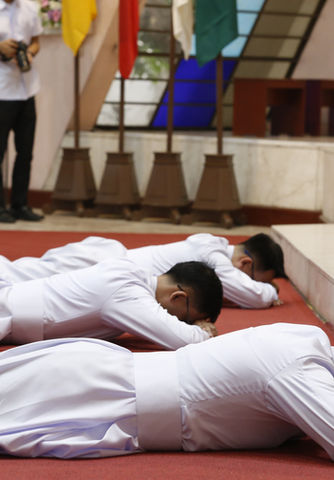7708 St. Paul Road, San Antonio Village, 1203 Makati City, Philippines,
(+632) 8895 9701 to 04. information@stpauls.ph.

"We were born from the Eucharist and we must live by the Eucharist." - Blessed James Alberione
The Paulines
The Society of Saint Paul (SSP) is a religious congregation founded in 1914 in Alba, Italy, by Blessed James Alberione. Its members, known as Paulines, are dedicated to proclaiming the Gospel through modern and effective means of communication.
Present in 32 countries across five continents, the Paulines fulfill their mission through publishing and bookstores, radio, television, and various forms of multimedia—both print and digital. Faithful to the charism of their founder, they seek to reach all people, especially those far from the C
Official Recognition
The Society was officially approved by the Holy See on June 27, 1949. Its mission is to "evangelize with the modern tools of communication." The SSP is composed of religious priests and lay consecrated members (Disciples of the Divine Master).
Their model of evangelization is based on Jesus the Divine Master, St. Paul the Apostle—who became “all things to all people”—and Mary, Queen of Apostles, who brought Christ into the world.
The mission of the Paulines is to bring the whole Christ—Way, Truth, and Life—into contact with the whole human person: mind, heart, and will. This is pursued through communication, using modern technology to share the Christian experience and to interpret human realities through the lens of the Gospel.
Fr. Alberione began with the printing press and later embraced cinema, radio, and television. Today, the Paulines strive to engage meaningfully in the evolving landscape of digital and multimedia communications, faithfully responding to his call to “put yourself forward” in service to the Church.
For the Paulines, communication is not merely a tool for evangelization—it is a form of preaching in itself, reaching those often beyond the reach of the parish.


Religious and Priestly Formation
The first Pauline missionaries arrived in the Philippines on July 7, 1935, establishing their initial community and formation house in Lipa City, Batangas. In 1941, they relocated to Pasay City, where formal academic studies began in the 1950s in partnership with Rizal City College.
In 1960, the seminary was transferred to Makati City. Five years later, in 1965, it received government recognition for its secondary education program. By 1968, it was authorized to offer a Bachelor of Arts in Liberal Arts, major in Philosophy with minors in History, English, or Graphic Arts. Due to rising operational costs, the high school department was phased out in 1989.
In 1993, the Saint Paul Seminary was transferred to Silang, Cavite, where it continues to offer government-recognized Bachelor of Arts degrees in Philosophy and in Communication. These programs aim to form future priests and religious with both intellectual depth and a commitment to apostolic service through media. Lay students also benefit from these academic offerings.
Following their undergraduate formation in Philosophy and Communication, Pauline formands proceed to Postulancy in San Fernando, Pampanga, and then to the Novitiate in Cebu City. Afterward, they pursue postgraduate theological studies at institutions such as Loyola School of Theology (Quezon City), San Carlos Graduate School of Theology (Makati City), and Maryhill School of Theology (Quezon City).
The formation journey culminates with the CORSO program in Rome, followed by Perpetual Profession and Ordination.




